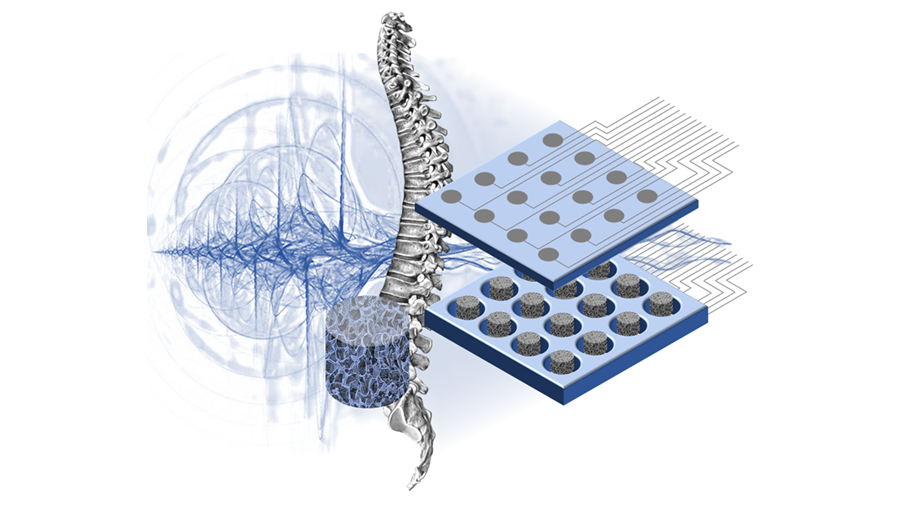Promoting neural regeneration with graphene-enriched scaffolds
NeuroStimSpinal combines materials science, electrical engineering, bioengineering and biomedicine to accelerate spinal cord injury repair
The Graphene Flagship partnering project NeuroStimSpinal aims to advance treatments in spinal cord injury, using graphene-enabled scaffolds and electrical stimulation. NeuroStimSpinal was launched in 2019 with a Future and Emerging Technology (FET Open) grant of 3.5 million euros. NeuroStimSpinal has joined the Graphene Flagship partnering division, establishing a link with the Graphene Flagship Work Package for Biomedical Technologies.
The NeuroStimSpinal team includes researchers from Graphene Flagship Associated Members University of Aveiro, Graphenest and Stemmatters from Portugal, and the Complutense University of Madrid from Spain, Radboud University Medical Centre from the Netherlands, and Graphene Flagship Partners Fundacion Tecnalia Research & Innovation from Spain and the Foundation for Research and Technology Hellas (FORTH) from Greece.
Damages to the spinal cord have traumatic neurological and pathological consequences that affect thousands of people worldwide. Neuroregenerative therapies aim to reconnect broken neural circuits across the injury site, allowing patients to move and sense again. These therapies often rely on tissue engineering and stem cells, which are capable of differentiating into other types of cells, including neurons. Electrical stimulation (ES) is often used to promote cellular growth and speed up the regeneration process. However, current ES technologies consist of invasive devices with spikes or needles that do not completely mimic the environment of the human spinal cord and do not allow a complete understanding of the synergetic effect of all the chemical, biological and electrical signals.
The NeuroStimSpinal team is developing novel graphene-enriched scaffolds that favour cell growth and proliferation, and induce stem cells (embryonic neural progenitor cells) to differentiate into neurons. Additionally, since graphene is an excellent electrical conductor, the scaffold supplies ES without the need for invasive needles or spikes, even at the micrometre scale. Once implanted in the damaged region of the spinal cord, the scaffold filled with stem cells can be electrically stimulated via wireless control.
While most ES devices have metal electrodes that are typically rigid and not easy to integrate into the body, NeuroStimSpinal scaffolds are structurally and chemically more similar to human tissues. To this end, Graphenest is producing a graphene-based ink used to create biocompatible electrodes that will be compatible with both polymer scaffolds and human tissues.
Currently, the team is analysing the synergetic effect of graphene-based materials in a protein-rich matrix, and evaluating the effect of ES on various tissues and diseases in the laboratory, using a test platform based on a unique graphene-based multielectrode array. The next step will be the production of graphene-enriched scaffolds for pre-clinical trials, key to approaching tests on animals.
Bruno Figueiredo from Graphenest is looking for new end-users and claims that, “At the pre-clinical stage, it is vital to understand how to create an ideal environment for the cells to grow and to prepare better scaffolds to implant.”
Using this graphene-enabled scaffold, researchers can mimic the electrical and biological characteristics of a real tissue environment and explore the best strategies for stem cell therapies. “We aim to provide a universal 3D platform allowing researchers all over the world to evaluate electrical inputs in combination with chemical, biological or mechanical aspects,” says NeuroStimSpinal coordinator Paula Alexandrina de Aguiar Pereira Marques from University of Aveiro.
We aim to provide a universal 3D platform allowing researchers all over the world to evaluate electrical inputs in combination with chemical, biological or mechanical aspects.
Coordinator of Graphene Flagship Partnering Project "Neurospinal"

Artistic representation of NeuroStimSpinal’s graphene-enabled scaffold for spinal cord injury repair (Credit: NeuroStimSpinal).




